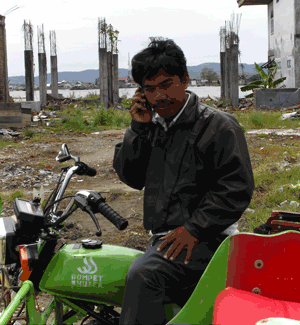|
In the wake of the terrible destruction wreaked by the 2004 Tsunami in Asia, some remarkable stories of survival are surfacing—one
involves the use of modern Information and Communication Technologies (ICT) as a disaster warning system:
Mr. Vijaykumar, a former volunteer at a telecenter in Nallavadu, India, run by the
M.S. Swaminathan Research Foundation. Vijaykumar,
who's now living in Singapore, received word of the tsunami well before anyone in southern India did. He called his family in Nallavadu,
then called the telecenter. Immediately the community sprung into action. Using the telecenter's public address system, local volunteers
alerted fellow villagers. Among the 500 families in Nallavadu, 150 of their houses were destroyed yet no one died, because the telecenter
 responded to the imminent crisis at a time
when no other local or national warning system was in place. (www.digitaldivide.net) responded to the imminent crisis at a time
when no other local or national warning system was in place. (www.digitaldivide.net)
It is clear that modern ICTs have the potential to save countless lives when used in conjunction with early warning systems.
Significant efforts are being directed at such risk-reduction activities within an overall disaster management strategy,
especially with an eye to their reduced costs and greater effectiveness as opposed to relief and rehabilitation required
after disaster strikes. As governments and scientists work to develop hi-tech warning systems involving seismological,
ocean-floor, tidal, and satellite technologies, the last-mile communication to those affected needs  consideration as well. consideration as well.
The existing communication infrastructure
such as the media systems (television and radio), fixed-line telephones and public address systems can play a role in informing
communities about impending disaster. However, these systems in under-developed rural locations may be constrained by requirements
of electricity and other physical infrastructure, may not always be available (or are too expensive) or not always be manned by a
working populace. On the other hand, the spread of communication technologies like mobile phones releases these constraints.
Requirements for Mobile Phones as an Early Warning System
1.Institutional requirements: Effective warning signals require timely communications, which can be enabled by coordination
among government warning systems, private telephony operators, and local communities (Following the tsunami, telecom providers
Ericsson and Motorola distributed cell-phones in local communities and in collaboration with the International Red Cross).
International governments need to clear legal considerations by signing MOUs outlining instantaneous sharing of information.
2.Technological requirements: At the system planning stage, technical systems of the scientists, government, and telephony
providers need to be compatible and linked. There needs to be adequate cellular coverage of communities at risk, as well as customization
of the user-experience to ensure that language, literacy, and techno-literacy are not barriers to usage. Maintenance of the infrastructure
and regular testing will ensure against system failure.
3.Financial considerations: The private telephony players and governments need to subsidize the financial costs of supporting
such a disaster-warning system, as well as ensure that at-risk populations can afford mobile-phones by providing low-cost solutions.
4.Human consideration: With the introduction of technology, one needs to be aware of shifts in risk perception by individuals
and communities, and the subsequent impact on behavior. At both ends of the spectrum, “false alarms” and “complacency” have been
demonstrated in the recent 2005 Mumbai flooding, and the Hurricane Katrina debacle respectively, with devastating impacts on human life.
Engaging local communities and their leaders in the planning process, recruiting interested and responsible volunteers, and training
exercises with the mobile phones may mitigate some of these concerns.
References |